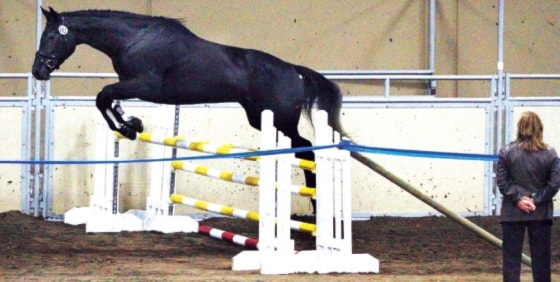Inspection awaited breeders, trainers and riders at the Canadian Warmblood Horse Breeders Association’s (CWHBA) Heartland Saddlery Open Warmblood Breeder’s Show.
The show was hosted at the Calnash Trucking Ag Event Centre for the first time, last weekend.
“Warmbloods have an inspection process,” said show co-ordinator Jill Owen. Mares and stallions must pass the inspection for their offspring to be registered with the association.
“You can actually fail. It’s part of our quality control,” said Owen. There were horses at the show that did fail their inspection.
Owen said Warmbloods are a European invention. The CWHBA is an extension of the European group’s standards, ideals and practices.
Owen said stallions are important to the association. “Most of our semen is imported from Europe.”
Warmbloods are bred to compete in three Olympic sports: dressage, jumping and eventing. They are also used in the hunter/jumper sport.
The horses are inspected on qualities including gait, conformation, parent verification, temperament and chute jumping.
According to Owen jumping is highly hereditary. Jumping horses have to be quick, careful, and must have scope. “They’re almost born with it,” said Owen.
Lineage and bloodlines are scrutinized. Owen said good jumpers usually have jumper genes that can be traced 10 horses back on both parents’ sides.
Owen also said jumper bloodlines shouldn’t be mixed with other horses. You can have a jumping horse in dressage lines, but you don’t want dressage bloodlines in a jumping horse.
“You’re always looking for a better standard of animal,” said Owen.
Dressage horses also have intelligent, trainable minds. According to Owen they started off as a military horse.
International Warmblood breeder Jacquie van den Bosch, from the Red Deer area, attended the show. Van den Bosch competes her horses at international shows such as Spruce Meadows. “You need a special breed. Most of the time we used a line that’s proved itself.”
Van den Bosch both breeds and raises international champions. “We (Jacquie and husband John) do lots of homework.”
They have a breeding process that has resulted in champions. “We let them be babies,” said van den Bosch.
By the time their horses are two or three they’re halter and saddle broke, and then returned to the field. At four they start competing in “baby classes.”
Van den Bosch said horses that don’t compete to standards are usually sold. “It’s a gamble.”
To stay at Spruce Meadow, one week costs approximately $2,000 per horse.
“The competition is very tough,” said van den Bosch. “It’s very hard on the horses. You have to have a good team to take care of the horses.”
However, the van den Boschs love the sport. “We love the horses and we love the competition.”
It takes about 12 years to train a Grand Prix horse but raising an international champion is the van den Boschs’ goal and prized achievement.
